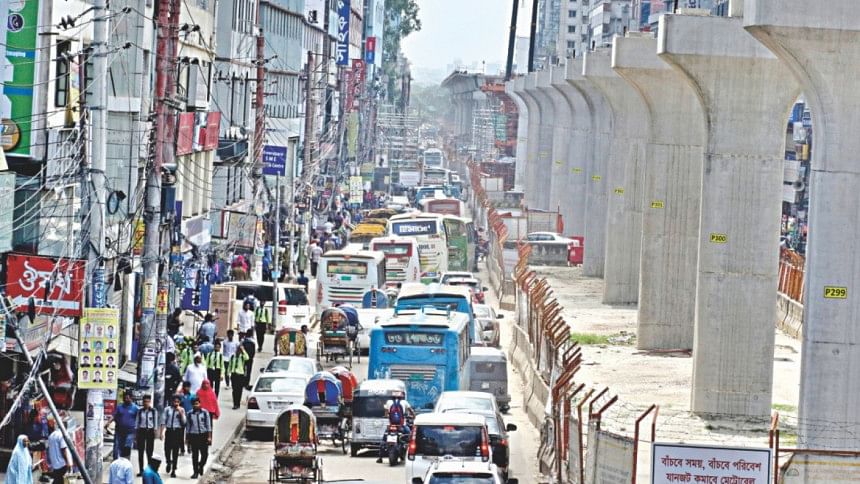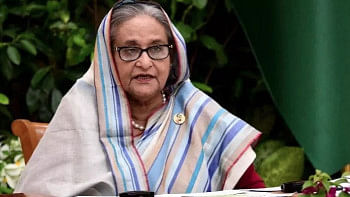Where has all the green gone?

As I pass the planning commission office in Agargaon on a rickshaw, on a jam-packed road in the evening, I cannot help noticing the big advertisements that have been put on the metro rail site stating how the project would bring blessings to this godforsaken city, once it is complete. The metro rail authorities are saying that it will ease the city's perennial traffic congestion, improve the city's environment by reducing the emission of greenhouse gas, and provide a faster, comfortable, reliable and environment-friendly means of public transportation.
According to Japan International Cooperation Agency (JICA), the metro line-6, from the north end of Uttara to Motijheel, would carry 60,000 passengers every hour in both directions. One would be able to travel this 20km distance in just 35 minutes, which sounds really amazing.
However, for the time being, the project seems to be causing more damage than good to the city's environment. The people of Mirpur particularly are the victims of this ongoing mega project. In September this year, a report of the Implementation Monitoring and Evaluation Division (IMED) of the Ministry of Planning has stated that the metro rail project sites are producing a huge amount of dust and creating noise pollution, posing a risk to public health. It has also said that Dhaka Mass Transport Company Ltd had failed to adequately implement the Environment Management Plan (EMP) of the metro rail project.
According to the report, many areas, including Kazipara, Shewrapara, Mirpur 10, Mirpur 11, where metro rail stations will be built, have witnessed waterlogging. Concerns were also raised about an increase in the waterlogging situation after the opening of the metro rail because the drainage and sewerage lines in these areas are inadequate.
Although the much-hyped metro rail project, which started some seven years ago, was supposed to end in December, 2020, the work has been delayed by a year and would need one more year to end, according to the authorities. The IMED report estimated that 45.6 percent of the construction from Uttara to Agargaon has been completed, and 23.12 percent work has been completed from Agargaon to Motijheel. And a total of 30 percent work of the project has been completed so far. So, the question is, will it be possible to complete the remaining 70 percent within the next two years?
Meanwhile, my travel time to and from work (from Mirpur to Farmgate) has increased significantly because of the traffic congestion resulting from the ongoing construction work of the project. According to the latest evaluation report of the Implementation Monitoring and Evaluation Division (IMED), it now takes 15 minutes for every passenger bus to pass every one kilometre of road whereas it should not take more than 10 minutes to reach Agargaon from Mirpur 10 roundabout, a distance of around 3.7 kilometres. This happened because the roads have been narrowed down to make space for the mega project.
However, what has been affecting people more than the traffic jam is the deteriorating air quality in the surrounding areas of the metro rail sites. Reportedly, because of this project, air pollution has reached an alarming level. Thus, further delay in completing the project would mean Dhaka's air quality would deteriorate even more. Earlier this month, a study report on air quality revealed that Dhaka's air remained "very unhealthy" and "extremely unhealthy" for 197 days of the last year. And the duration of the "unhealthy air" level is increasing day by day. The situation seems to have aggravated in the last one month alone. With reduced rainfall, the amount of dust from the construction sites has increased, making the air unsuitable for breathing.
Being a regular commuter from Mirpur to Farmgate, I can literally feel the difference in the air between now and, say, five years ago. Nowadays, while travelling on this road, I often feel that I can't get enough air into my lungs. Although I have always been using a mask to save myself from the toxic dusty air of Dhaka, it doesn't seem to help much these days. In this part of the city, travelling by public transport has become really difficult for people with dust, sound pollution and black smoke from vehicles taking a toll on their health every day.
But it's not just the dust and smoke from vehicles that have ruined the city's air, the fast vanishing trees and plants along the metro rail sites definitely have a big role to play here. The rows of big trees on both sides of the Begum Rokeya Sarani was a sight to behold only a few years ago. Even the road dividers from Farmgate to the Mirpur 10 roundabout had big trees such as mahogany, shishu, akashmoni, etc. But now very few such trees are seen on the road from Agargaon to Mirpur 10, because most of them were cut down to make room for the metro rail.
The open spaces in front of the Agargaon colony beside Sher-e-Bangla Agricultural University were taken up by the metro authorities; the nurseries in the area were evicted. One by one, all the breathing spaces in the area were gone and I have been a witness to all these unfortunate events.
I was particularly shocked to see the fate of Shaheed Anwara Park, the lone public park in the city's Farmgate area. I do not know exactly when the park was built, but ever since I became familiar with Farmgate area, I have seen that park. The total area of the park was 5.21 acre, big enough for local residents as well as pedestrians to take a stroll and rest during their day-to-day commute through the area. Not that the park was always in good condition. Often it would remain occupied by drug addicts and all sorts unlawful activities would happen there. It would often be rented out to hold religious congregations by a local peer. But it was renovated quite a few times. And for the past few years, the park was in good condition and people of the neighbouring areas had finally found a breathing space. Sadly, this park has been acquired by the metro rail authorities and it is now being used as a metro rail station.
It is true that the benefits of the soon-to-be completed first ever MRT project of the country would be many. According to transport experts, when all five metro rail systems are complete, it will reduce the city's traffic problem significantly, and provide a modern, comfortable transport service to city residents.
But sadly, we have not yet heard of any plan to green the project sites by the government or the metro rail authorities. In order to compensate for the trees that had to be cut down for this mega project, the metro rail authorities should take a massive plan of planting trees in the project areas. Because, at the end of the day, being able to breathe matters more than a fast and modern public transport system.
Naznin Tithi is a member of the editorial team at The Daily Star.

 For all latest news, follow The Daily Star's Google News channel.
For all latest news, follow The Daily Star's Google News channel. 



Comments